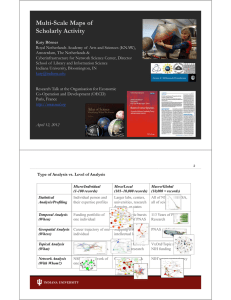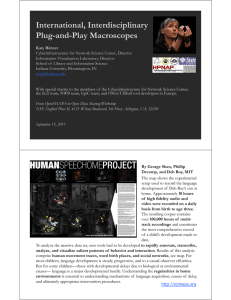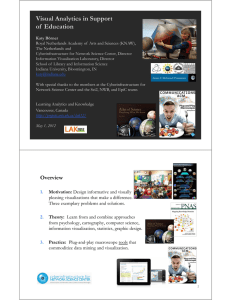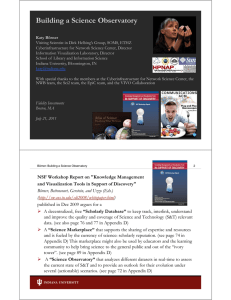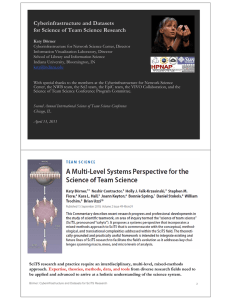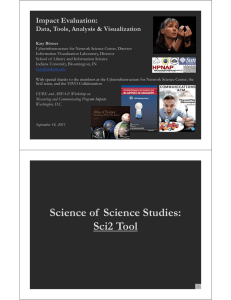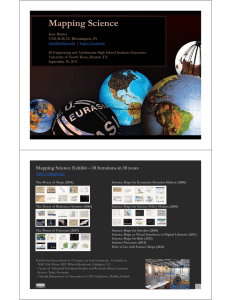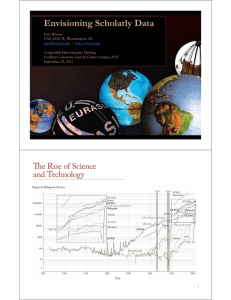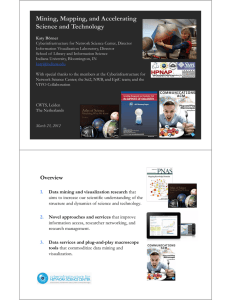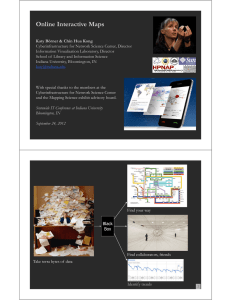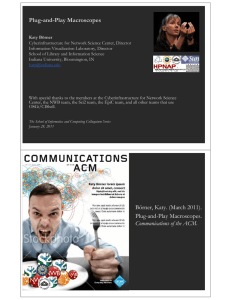Building a Science Observatory: Data, Tools, and Maps
advertisement
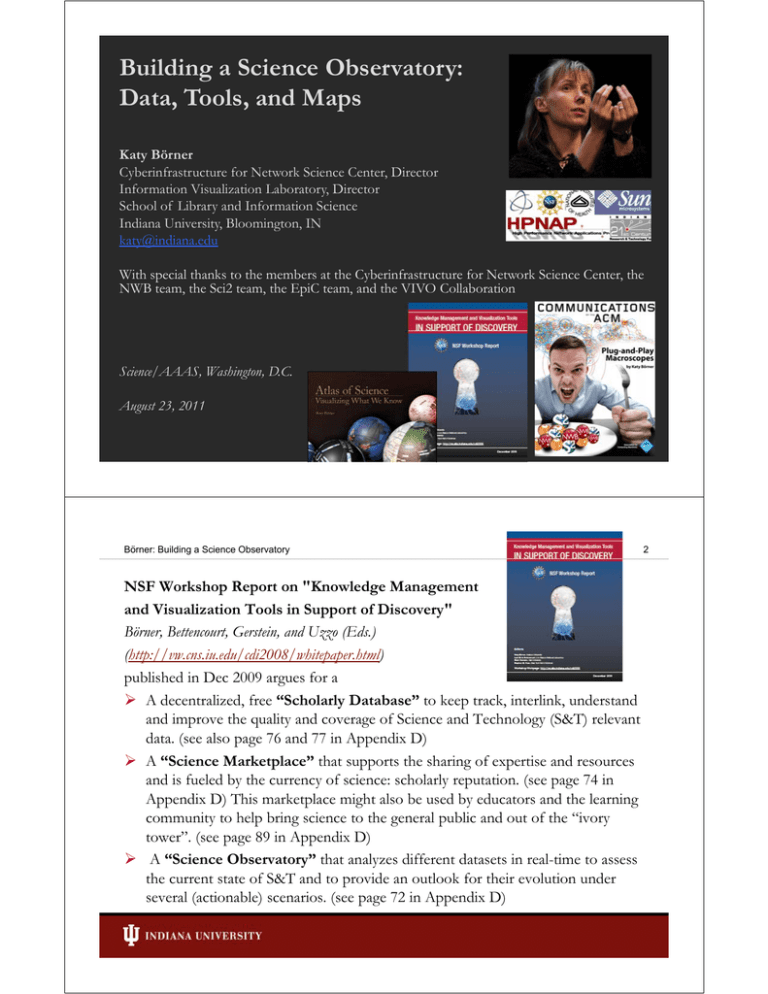
Building a Science Observatory: Data, Tools, and Maps Katy Börner Cyberinfrastructure for Network Science Center, Director Information Visualization Laboratory, Director School of Library and Information Science Indiana University, Bloomington, IN katy@indiana.edu With special thanks to the members at the Cyberinfrastructure for Network Science Center, the NWB team, the Sci2 team, the EpiC team, and the VIVO Collaboration Science/AAAS, Washington, D.C. August 23, 2011 Börner: Building a Science Observatory NSF Workshop Report on "Knowledge Management and Visualization Tools in Support of Discovery" Börner, Bettencourt, Gerstein, and Uzzo (Eds.) (http://vw.cns.iu.edu/cdi2008/whitepaper.html) published in Dec 2009 argues for a A decentralized, free “Scholarly Database” to keep track, interlink, understand and improve the quality and coverage of Science and Technology (S&T) relevant data. (see also page 76 and 77 in Appendix D) A “Science Marketplace” that supports the sharing of expertise and resources and is fueled by the currency of science: scholarly reputation. (see page 74 in Appendix D) This marketplace might also be used by educators and the learning community to help bring science to the general public and out of the “ivory tower”. (see page 89 in Appendix D) A “Science Observatory” that analyzes different datasets in real-time to assess the current state of S&T and to provide an outlook for their evolution under several (actionable) scenarios. (see page 72 in Appendix D) 2 Börner: Building a Science Observatory 3 “Validate Science [of Science Results and] Maps” to understand and utilize their value for communicating science studies and models across scientific boundaries, but also to study and communicate the longitudinal (1980-today) impact of funding on the science system. (see page 81 in Appendix D) An easy to use, yet versatile, “Science Telescope” to communicate the structure and evolution of science to researchers, educators, industry, policy makers, and the general public at large. (see page 87 in Appendix D) The effect of this (and other science portals) on education and science perception needs to be studied in carefully controlled experiments. (see page 88 in Appendix D) “Science of (Team) Science” studies are necessary to increase our understanding and support the formation of effective research and development teams. (see page 78 and 82 in Appendix D). “Success Criteria” need to be developed that support a scientific calculation of S&T benefits for society. (see also page 88 in Appendix D) A “Science Life” (an analog to Second Life) should be created to put the scientist’s face on their science. Portals to this parallel world would be installed in universities, libraries and science museums. (see page 80 in Appendix D) Börner: Building a Science Observatory Science of (team) science research and practice requires an interdisciplinary, multi-level, mixed-methods approach. 4 Börner: Building a Science Observatory 5 Modeling Science Dynamics using multi-level, mixed methods, and multi-perspective models Katy Börner, Kevin W. Boyack, Staša Milojević, Steven Morris. (2011) An introduction to modeling science: Basic model types, key definitions, and a general framework for the comparison of process models. In Scharnhorst, Andrea, Börner, van den Besselaar (Eds) Models of Science Dynamics. Springer Verlag. Börner: Building a Science Observatory 6 Descriptive Models of Science Detect advances of scientific knowledge via "longitudinal mapping" (Garfield, 1994). Synthesis of specialty narratives from co-citation clusters (Small, 1986). Identify cross-disciplinary fertilization via "passages through science" (Small, 1999, 2000). Understand scholarly information foraging (Sandstrom, 2001). Knowledge discovery in un-connected terms (Swanson & Smalheiser, 1997). Determine areas of expertise for specific researcher, research group via "invisible colleges" (note that researchers self definition might differ from how field defines him/her) (Crane, 1972). Identify profiles of authors, also called CAMEOS, to be used to for document retrieval or to map an author’s subject matter and studying his/her publishing career, or to map the social and intellectual networks evident in citations to and from authors and in co-authorships (White, 2001). Börner: Building a Science Observatory 7 Descriptive Models of Science cont. Identification of scientific frontiers http://www.science-frontiers.com/. ISI's Essential Science Indicators http://essentialscience.com/ Import-export studies (Stigler, 1994). Evaluation of 'big science' facilities using 'converging partial indicators' (Martin, 1996; Martin & Irvine, 1983). Input (levels of funding, expertise of scientists, facilities used) - output (publications, patents, Nobel prices, improved health, reduced environment insults, etc. - influenced by political, economic, financial, and legal factors studies (Kostroff & DelRio, 2001). Determine influence of funding on research output (Boyack & Borner, 2002). How to write highly influential paper (van Dalen & Henkens, 2001). Börner: Building a Science Observatory Process Models of Science Can be used to predict the effects of Large collaborations vs. single author research on information diffusion. Different publishing mechanisms, e.g., E-journals vs. books on co-authorship, speed of publication, etc. Supporting disciplinary vs. interdisciplinary collaborations. Many small vs. one large grant on # publications, Ph.D. students, etc. Resource distribution on research output. … In general, process model provide a means to analyze the structure and dynamics of science -- to study science using the scientific methods of science as suggested by Derek J. deSolla Price about 40 years ago. 8 Council for Chemical Research. 2009. Chemical R&D Powers the U.S. Innovation Engine. Washington, DC. Courtesy of the Council for Chemical Research. 9 Bollen, Johan, Herbert Van de Sompel, Aric Hagberg, Luis M.A. Bettencourt, Ryan Chute, Marko A. Rodriquez, Lyudmila Balakireva. 2008. A Clickstream Map of Science. 10 Cesar A. Hidalgo, Bailey Klinger, Albert-László Barabási , Ricardo Hausmann . 2007. The Product Space Adrian White and the National Geographic EarthPulse Team. 2008. A Global Projection of Subjective Well-being 11 12 Börner: Building a Science Observatory 13 Different Stakeholder Groups and Their Needs Funding Agencies Need to monitor (long-term) money flow and research developments, identify areas for future development, stimulate new research areas, evaluate funding strategies for different programs, decide on project durations, funding patterns. Scholars Want easy access to research results, relevant funding programs and their success rates, potential collaborators, competitors, related projects/publications (research push). Industry Is interested in fast and easy access to major results, experts, etc. Influences the direction of research by entering information on needed technologies (industry-pull). Advantages for Publishers Need easy to use interfaces to massive amounts of interlinked data. Need to communicate data provenance, quality, and context. Society Needs easy access to scientific knowledge and expertise. Börner: Building a Science Observatory 14 Scholars Have Different Roles/Needs Researchers and Authors—need to select promising research topics, students, collaborators, and publication venues to increase their reputation. They benefit from a global view of competencies, reputation and connectivity of scholars; hot and cold research topics and bursts of activity, and funding available per research area. Editors—have to determine editorial board members, assign papers to reviewers, and ultimately accept or reject papers. Editors need to know the position of their journals in the evolving world of science. They need to advertise their journals appropriately and attract high-quality submissions, which will in turn increase the journal’s reputation and lead to higher quality submissions. Reviewers—read, critique, and suggest changes to help improve the quality of papers and funding proposals. They need to identify related works that should be cited or complementary skills that authors might consider when selecting project collaborators. Teachers—teach classes, train doctoral students, and supervise postdoctoral researchers. They need to identify key works, experts, and examples relevant to a topic area and teach them in the context of global science. Inventors—create intellectual property and obtain patents, thus needing to navigate and make sense of research spaces as well as intellectual property spaces. Investigators—scholars acquire funding to support students, hire staff, purchase equipment, or attend conferences. Here, research interests and proposals have to be matched with existing federal and commercial funding opportunities, possible industry collaborators and sponsors. Team Leads and Science Administrators—many scholars direct multiple research projects simultaneously. Some have full-time staff, research scientists, and technicians in their laboratories and centers. Leaders need to evaluate performance and provide references for current or previous members; report the progress of different projects to funding agencies. Expertise – identify and access it at the perfect moment using, e.g., Facebook, LinkedIn, Academia, VIVO, Harvard Profiles, Elsevier’s Collexis, Loki, Stanford’s CAP, or other systems. BUT: Also need access to research data, software, resources. 15 VIVO: A Semantic Approach to Creating a National Network of Researchers (http://vivoweb.org) • Semantic web application and ontology editor originally developed at Cornell U. • Integrates research and scholarship info from systems of record across institution(s). • Facilitates research discovery and crossdisciplinary collaboration. • Simplify reporting tasks, e.g., generate biosketch, department report. Funded by $12 million NIH award. Cornell University: Dean Krafft (Cornell PI), Manolo Bevia, Jim Blake, Nick Cappadona, Brian Caruso, Jon Corson-Rikert, Elly Cramer, Medha Devare, John Fereira, Brian Lowe, Stella Mitchell, Holly Mistlebauer, Anup Sawant, Christopher Westling, Rebecca Younes. University of Florida: Mike Conlon (VIVO and UF PI), Cecilia Botero, Kerry Britt, Erin Brooks, Amy Buhler, Ellie Bushhousen, Chris Case, Valrie Davis, Nita Ferree, Chris Haines, Rae Jesano, Margeaux Johnson, Sara Kreinest, Yang Li, Paula Markes, Sara Russell Gonzalez, Alexander Rockwell, Nancy Schaefer, Michele R. Tennant, George Hack, Chris Barnes, Narayan Raum, Brenda Stevens, Alicia Turner, Stephen Williams. Indiana University: Katy Borner (IU PI), William Barnett, Shanshan Chen, Ying Ding, Russell Duhon, Jon Dunn, Micah Linnemeier, Nianli Ma, Robert McDonald, Barbara Ann O'Leary, Mark Price, Yuyin Sun, Alan Walsh, Brian Wheeler, Angela Zoss. Ponce School of Medicine: Richard Noel (Ponce PI), Ricardo Espada, Damaris Torres. The Scripps Research Institute: Gerald Joyce (Scripps PI), Greg Dunlap, Catherine Dunn, Brant Kelley, Paula King, Angela Murrell, Barbara Noble, Cary Thomas, Michaeleen Trimarchi. Washington University, St. Louis: Rakesh Nagarajan (WUSTL PI), Kristi L. Holmes, Sunita B. Koul, Leslie D. McIntosh. Weill Cornell Medical College: Curtis Cole (Weill PI), Paul Albert, Victor Brodsky, Adam Cheriff, Oscar Cruz, Dan Dickinson, Chris Huang, Itay Klaz, Peter Michelini, Grace Migliorisi, John Ruffing, Jason Specland, Tru Tran, Jesse Turner, Vinay Varughese. Type of Analysis vs. Level of Analysis Micro/Individual (1-100 records) Meso/Local (101–10,000 records) Macro/Global (10,000 < records) Statistical Analysis/Profiling Individual person and their expertise profiles Larger labs, centers, universities, research domains, or states All of NSF, all of USA, all of science. Temporal Analysis (When) Funding portfolio of one individual Mapping topic bursts in 20-years of PNAS 113 Years of Physics Research Geospatial Analysis (Where) Career trajectory of one individual Mapping a states intellectual landscape PNAS publications Topical Analysis (What) Base knowledge from which one grant draws. Knowledge flows in Chemistry research VxOrd/Topic maps of NIH funding Network Analysis (With Whom?) NSF Co-PI network of one individual Co-author network NIH’s core competency 19 Temporal Analysis (When) Temporal visualizations of the number of papers/funding award at the institution, school, department, and people level 20 Topical Analysis (What) Science map overlays will show where a person, department, or university publishes most in the world of science. (in work) 21 Network Analysis (With Whom?) Who is co-authoring, co-investigating, co-inventing with whom? What teams are most productive in what projects? 22 http://nrn.cns.iu.edu Geospatial Analysis (Where) Where is what science performed by whom? Science is global and needs to be studied globally. (in work) Few have access to or time to visit “Visualization Domes” Overview, Interactivity, Details on Demand must come to commonly used devices and environments Second Annual VIVO Conference August 24-26, 2011 Gaylord National, Washington D.C. http://vivoweb.org/conference VIVO is supported by NIH Award U24 RR029822 Tools – continuously identify, learn, advance, share code, e.g., via Plug-and-Play Macroscopes 26 Börner, Katy. (March 2011). Plug-and-Play Macroscopes. Communications of the ACM, 54(3), 60-69. Video and paper are at http://www.scivee.tv/node/27704 27 Designing “Dream Tools” scientists keen to observe and comprehend what no one has seen or understood before. Galileo Galilei (1564–1642) Many of the best micro-, tele-, and macroscopes are designed by recognized the potential of a spyglass for the study of the heavens, ground and polished his own lenses, and used the improved optical instruments to make discoveries like the moons of Jupiter, providing quantitative evidence for the Copernican theory. Today, scientists repurpose, extend, and invent new hardware and software to “macroscopes” that may solve both local and create global challenges. empower me, my students, colleagues, and Plug-and-play macroscopes 100,000 others that downloaded them. 28 Macroscopes Decision making in science, industry, and politics, as well as in daily life, requires that we make sense of data sets representing the structure and dynamics of complex systems. Analysis, navigation, and management of these continuously evolving data sets require a new kind of data-analysis and visualization tool we call a macroscope (from the Greek macros, or “great,” and skopein, or “to observe”) inspired by de Rosnay’s futurist science writings. Macroscopes provide a “vision of the whole,” helping us “synthesize” the related elements and enabling us to detect patterns, trends, and outliers while granting access to myriad details. Rather than make things larger or smaller, macroscopes let us observe what is at once too great, slow, or complex for the human eye and mind to notice and comprehend. Microscopes Telescopes Macroscopes 29 Macroscopes cont. While microscopes and telescopes are physical instruments, macroscopes resemble continuously changing bundles of software plug-ins. Macroscopes make it easy to select and combine algorithm and tool plug-ins but also interface plug-ins, workflow support, logging, scheduling, and other plug-ins needed for scientifically rigorous yet effective work. They make it easy to share plug-ins via email, flash drives, or online. To use new plugins, simply copy the files into the plug-in directory, and they appear in the tool menu ready for use. No restart of the tool is necessary. Sharing algorithm components, tools, or novel interfaces becomes as easy as sharing images on Flickr or videos on YouTube. Assembling custom tools is as quick as compiling your custom music collection. 30 Macroscopes Serve the Changing Scientific Landscape Different datasets/formats. Diverse algorithms/tools written in many programming languages. Health Finance Crime Smart Cities Epidemiology 31 Related Work Google Code and SourceForge.net provide special means for developing and distributing software In August 2009, SourceForge.net hosted more than 230,000 software projects by two million registered users (285,957 in January 2011); In August 2009 ProgrammableWeb.com hosted 1,366 application programming interfaces (APIs) and 4,092 mashups (2,699 APIs and 5,493 mashups in January 2011) Cyberinfrastructures serving large biomedical communities Cancer Biomedical Informatics Grid (caBIG) (http://cabig.nci.nih.gov) Biomedical Informatics Research Network (BIRN) (http://nbirn.net) Informatics for Integrating Biology and the Bedside (i2b2) (https://www.i2b2.org) HUBzero (http://hubzero.org) platform for scientific collaboration uses myExperiment (http://myexperiment.org) supports the sharing of scientific workflows and other research objects. Missing so far is a common standard for the design of modular, compatible algorithm and tool plug-ins (also called “modules” or “components”) that can be easily combined into scientific workflows (“pipeline” or “composition”), and packaged as custom tools. 32 OSGi & CIShell CIShell (http://cishell.org) is an open source software specification for the integration and utilization of datasets, algorithms, and tools. It extends the Open Services Gateway Initiative (OSGi) (http://osgi.org), a standardized, component oriented, computing environment for networked services widely used in industry since more than 10 years. Specifically, CIShell provides “sockets” into which existing and new datasets, algorithms, and tools can be plugged using a wizard-driven process. Developers Workflow Alg Alg Users CIShell Wizards Alg CIShell Sci2 Tool Workflow NWB Tool Tool Workflow Workflow Tool 33 CIShell Developer Guide (http://cishell.wiki.cns.iu.edu) 34 CIShell Portal (http://cishell.org) 35 Network Workbench Tool http://nwb.cns.edu The Network Workbench (NWB) tool supports researchers, educators, and practitioners interested in the study of biomedical, social and behavioral science, physics, and other networks. In February 2009, the tool provides more 169 plugins that support the preprocessing, analysis, modeling, and visualization of networks. More than 50 of these plugins can be applied or were specifically designed for S&T studies. It has been downloaded more than 65,000 times since December 2006. Herr II, Bruce W., Huang, Weixia (Bonnie), Penumarthy, Shashikant & Börner, Katy. (2007). Designing Highly Flexible and Usable Cyberinfrastructures for Convergence. In Bainbridge, William S. & Roco, Mihail C. (Eds.), Progress in Convergence - Technologies for Human Wellbeing (Vol. 1093, pp. 161-179), Annals of the New York Academy of Sciences, Boston, MA. 36 http://sci2.cns.iu.edu http://sci2.wiki.cns.iu.edu 37 Sci2 Tool – “Open Code for S&T Assessment” OSGi/CIShell powered tool with NWB plugins and many new scientometrics and visualizations plugins. Sci Maps GUESS Network Vis Horizontal Time Graphs Börner, Katy, Huang, Weixia (Bonnie), Linnemeier, Micah, Duhon, Russell Jackson, Phillips, Patrick, Ma, Nianli, Zoss, Angela, Guo, Hanning & Price, Mark. (2009). Rete-Netzwerk-Red: Analyzing and Visualizing Scholarly Networks Using the Scholarly Database and the Network Workbench Tool. Proceedings of ISSI 2009: 12th International Conference on Scientometrics and Informetrics, Rio de Janeiro, Brazil, July 14-17 . Vol. 2, pp. 619-630. Sci2 Tool Geo Maps Circular Hierarchy 40 Europe OSGi/CIShell Adoption Europe USA A number of other projects recently adopted OSGi and/or CIShell: Cytoscape (http://cytoscape.org) Led by Trey Ideker at the University of California, San Diego is an open source bioinformatics software platform for visualizing molecular interaction networks and integrating these interactions with gene expression profiles and other state data (Shannon et al., 2002). MAEviz (https://wiki.ncsa.uiuc.edu/display/MAE/Home) Managed by Jong Lee at NCSA is an open-source, extensible software platform which supports seismic risk assessment based on the Mid-America Earthquake (MAE) Center research. Taverna Workbench (http://taverna.org.uk) Developed by the myGrid team (http://mygrid.org.uk) led by Carol Goble at the University of Manchester, U.K. is a free software tool for designing and executing workflows (Hull et al., 2006). Taverna allows users to integrate many different software tools, including over 30,000 web services. TEXTrend (http://textrend.org) Led by George Kampis at Eötvös Loránd University, Budapest, Hungary supports natural language processing (NLP), classification/mining, and graph algorithms for the analysis of business and governmental text corpuses with an inherently temporal component. DynaNets (http://www.dynanets.org) Coordinated by Peter M.A. Sloot at the University of Amsterdam, The Netherlands develops algorithms to study evolving networks. SISOB (http://sisob.lcc.uma.es) An Observatory for Science in Society Based in Social Models. As the functionality of OSGi-based software frameworks improves and the number and diversity of dataset and algorithm plugins increases, the capabilities of custom tools will expand. Map – effectively communicate the structure and dynamics of science to different stakeholders using (interactive) visualizations. 42 Mapping Science Exhibit – 10 Iterations in 10 years http://scimaps.org Mapping Science Exhibit at MEDIA X, Wallenberg Hall, Stanford University http://mediax.stanford.edu, http://scaleindependentthought.typepad.com/photos/scimaps 43 Mapping Science Exhibit – 10 Iterations in 10 years http://scimaps.org The Power of Maps (2005) Science Maps for Economic Decision Makers (2008) The Power of Reference Systems (2006) Science Maps for Science Policy Makers (2009) The Power of Forecasts (2007) Science Maps for Scholars (2010) Science Maps as Visual Interfaces to Digital Libraries (2011) Science Maps for Kids (2012) Science Forecasts (2013) Towards Science Mapping Standards (2014) Exhibit has been shown in 72 venues on four continents. Currently at - NSF, 10th Floor, 4201 Wilson Boulevard, Arlington, VA - Center of Advanced European Studies and Research, Bonn, Germany - University of North Texas, Denton, Texas 44 Science Maps in “Expedition Zukunft” science train visiting 62 cities in 7 months, 12 coaches, 300 m long. http://www.expedition-zukunft.de 46 Science & Technology Forecasts @ Times Square in 2016 This is the only mockup in this slide show. Everything else is available today. 47 References Börner, Katy, Chen, Chaomei, and Boyack, Kevin. (2003). Visualizing Knowledge Domains. In Blaise Cronin (Ed.), ARIST, Medford, NJ: Information Today, Volume 37, Chapter 5, pp. 179-255. http://ivl.slis.indiana.edu/km/pub/2003-borner-arist.pdf Shiffrin, Richard M. and Börner, Katy (Eds.) (2004). Mapping Knowledge Domains. Proceedings of the National Academy of Sciences of the United States of America, 101(Suppl_1). http://www.pnas.org/content/vol101/suppl_1/ Börner, Katy, Sanyal, Soma and Vespignani, Alessandro (2007). Network Science. In Blaise Cronin (Ed.), ARIST, Information Today, Inc., Volume 41, Chapter 12, pp. 537607. http://ivl.slis.indiana.edu/km/pub/2007-borner-arist.pdf Börner, Katy (2010) Atlas of Science. MIT Press. http://scimaps.org/atlas Scharnhorst, Andrea, Börner, Katy, van den Besselaar, Peter (2011) Models of Science Dynamics. Springer Verlag. 48 All papers, maps, tools, talks, press are linked from http://cns.iu.edu CNS Facebook: http://www.facebook.com/cnscenter Mapping Science Exhibit Facebook: http://www.facebook.com/mappingscience 49
